Disclosure: This post may contain affiliate links. I may earn a small commission for my endorsement, recommendation, testimonial, and/or link to any products or services from this website.
Homemade quick pickles have never been easier! These refrigerator dill pickles are the perfect way to take advantage of crisp, fresh cucumbers — without the hassle of canning. They’ll even last for a month or two! Serve the refrigerator pickles on hamburgers and sandwiches, as a snack, or as a salad alongside barbecue or other meat-based entrées. They have just the right balance of fresh dill, garlic, onions and cider vinegar, for a light, refreshing taste without an overpowering tang.
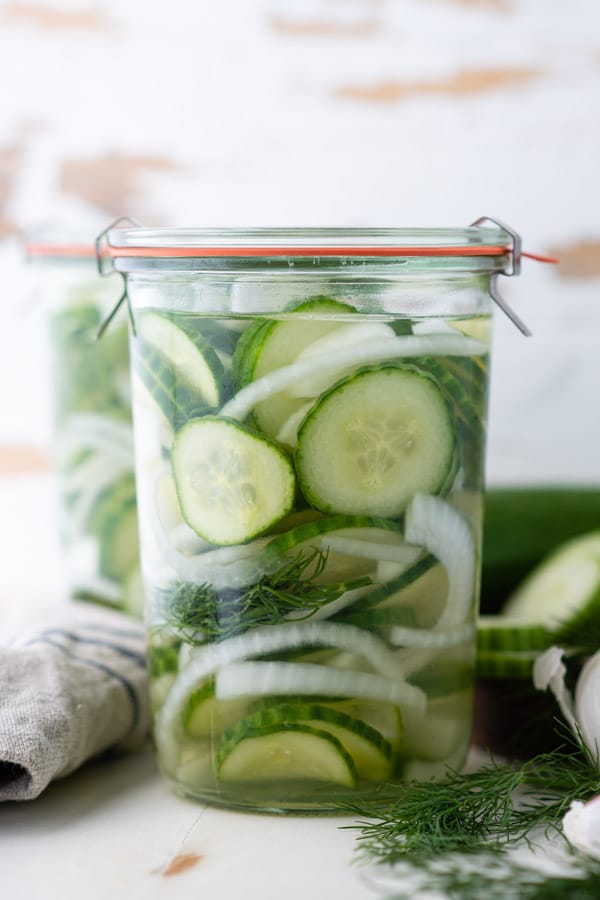
Refrigerator Pickles
“Refrigerator pickles” is a generic term used to describe fresh pickles that are stored in the fridge, rather than pickles that are waterbath canned for shelf-storage. In other words, these “quick pickles” are faster and easier than their canned counterparts! This particular refrigerator dill pickle recipe is salty — not sweet — and has a subtle tang from a bit of cider vinegar, a hint of garlic, and plenty of fresh dill. They’re a favorite around here because they’re not overpowering in the way that other pickles can make your mouth pucker from so much sour vinegar! Instead, these homemade pickles and sweet onions taste light and fresh, and remind me of my mom’s vinegar-based cucumber salad.
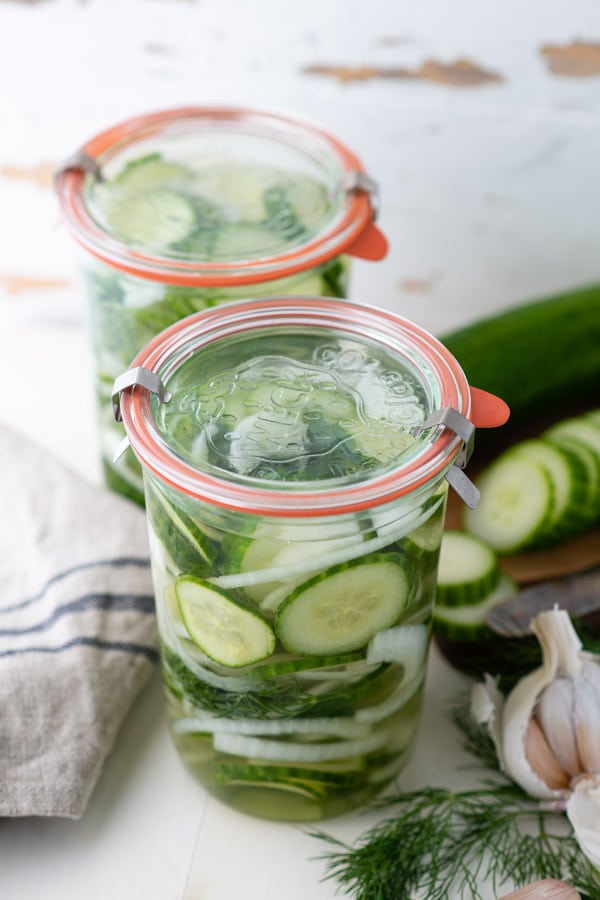
Ingredients
This is just a quick overview of the ingredients that you’ll need to prepare a batch of fresh pickles. As always, specific measurements and step-by-step instructions can be found in the printable recipe box at the bottom of the post.
- Water: the base of the brine.
- Cider vinegar: has a mellow, fruity flavor that works well for a mild pickle. It’s less pungent and harsh than distilled white vinegar.
- Kosher salt: flavors the pickles and helps to keep them fresh.
- Granulated sugar: just enough to balance the savory flavor of the pickles.
- Garlic: one clove infuses the brine with a very subtle hint of garlic flavor. If you prefer a stronger garlic pickle, you can add one or two peeled cloves to each jar.
- Cucumbers: fresh, seedless English cucumbers are my choice here, but small pickling cucumbers (when available) are also a good option.
- Vidalia onions: classic sweet Southern onions that pair so well with the cucumbers. If you can’t find Vidalia onions where you live, substitute with any other sweet onion variety.
- Fresh dill: gives the pickles their signature dill taste.
The Best Cucumbers for Pickles
I like to use seedless English cucumbers here, since they’re easy to purchase at just about any grocery store and they don’t have large seeds to contend with. Plus, when sliced into rounds, they’re the perfect size for pickles! Pickling cucumbers, which are shorter and have a bumpy skin, also work well because they hold up for a long time and stay nice and crisp. They can be harder to find, but are a great option when they’re in season at the local farmers’ market.
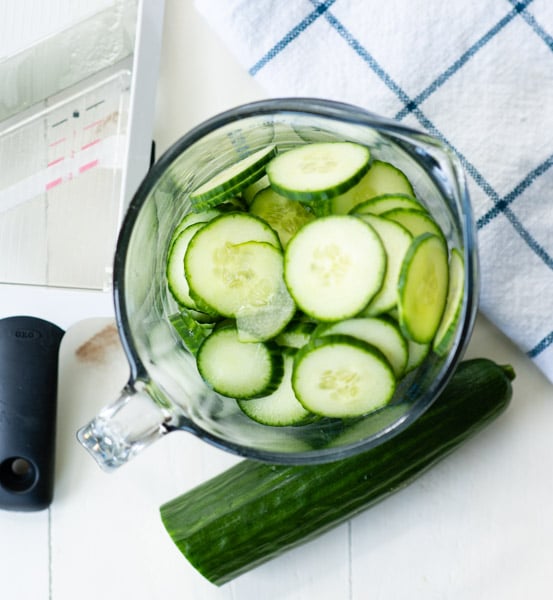
How to Make Refrigerator Dill Pickles with Onions
The process of making refrigerator dill pickles is really quite simple: you just soak cucumbers in a brine made from water, vinegar and salt, along with any other seasonings that you like (in this case, dill). As the cucumbers soak in the brine, they become pickles!
- Boil the water, vinegar, salt, sugar and garlic over medium-high heat, whisking to make sure that the salt and sugar dissolve.
- Remove the brine from the heat and let it cool to room temperature.
- Divide the cucumbers, onions and dill sprigs between jars.
- Add the cooled vinegar mixture to cover, then seal the jars.
- Refrigerate for at least 24 hours before enjoying.
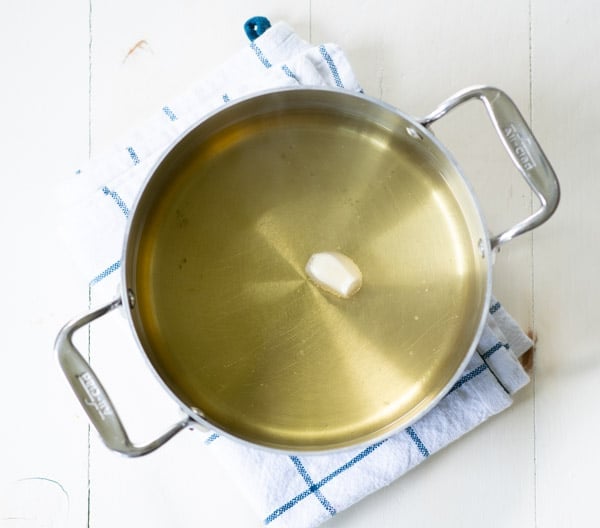
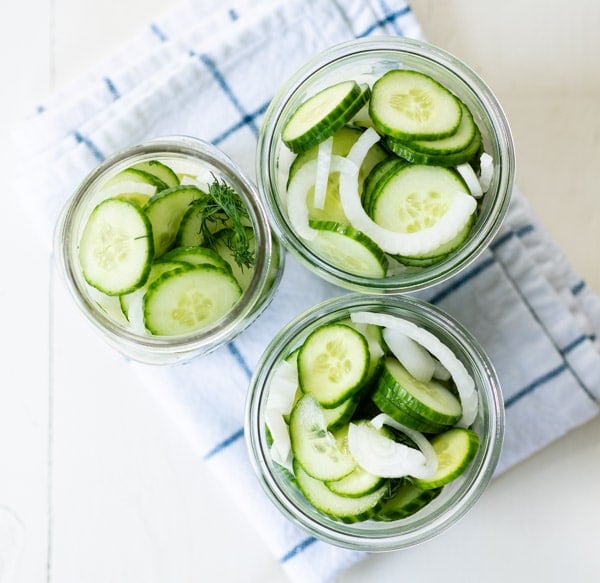
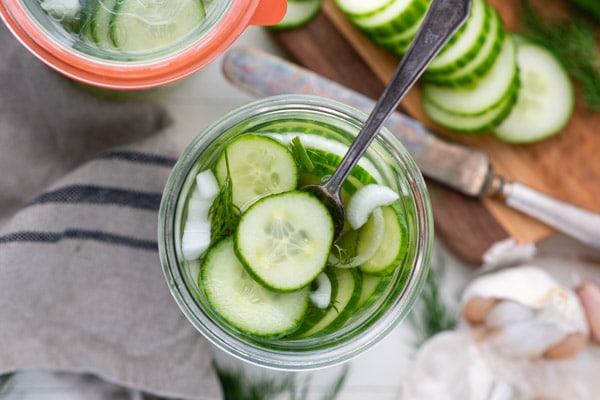
What to Serve with Quick Pickles
While you can certainly enjoy the refrigerator dill pickles as a condiment, putting slices on burgers, sandwiches or barbecue, you can also treat them like a side dish and serve a spoonful as you would serve a salad. Since the crispy cucumbers and sweet onions are mild and zippy, they’re a nice acidic contrast to heartier meat-based entrees — like ribs, fried chicken, fried fish or shrimp, and grilled steak. Plus, they might just become a staple in your fridge for those moments when you need to stick your fingers in a jar for a quick, refreshing snack!
Here are some great meals to pair with your homemade pickles:
- Baby Back Ribs
- Crock Pot Beef Barbacoa
- Grilled Hamburgers
- Chicken Salad Sandwiches or Egg Salad Sandwiches
- Fried Chicken, Chicken Tenders, Fried Chicken Cutlets and Country Gravy, or Homemade Chicken Nuggets
- Ranch Oven-Fried Chicken
- Grilled BBQ Pork Chops
- Sloppy Joes
- Beef Barbecue
- Fried Catfish or Oven-Fried Fish
- Grilled BBQ Chicken Breast
- Grilled Shrimp or Crispy Fried Shrimp
- London Broil, Grilled Flank Steak or Grilled NY Strip Steak
- Chicken Fried Steak with Gravy
- Grilled Pork Tenderloin
- Dr. Pepper Pulled Pork, Cider Braised Pork Shoulder, Mississippi Roasted Pork Shoulder or Slow Cooker Pulled Pork with Alabama White Barbecue Sauce
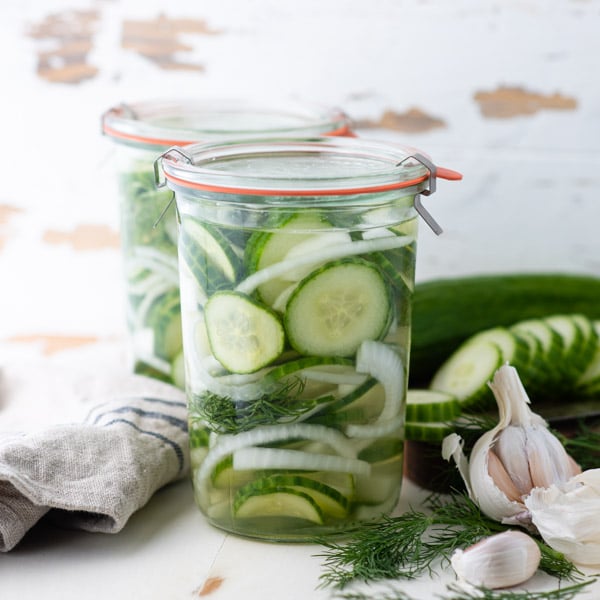
Storage
Store the pickles in an airtight jar or other container for up to 2 months in the fridge. They will get softer as they sit, so we try to enjoy them within the first few weeks of preparation.
Recipe Variations
- Some pickle recipes use equal parts vinegar and water for the brine. This brine is more mild and less tangy, which we really love (and it makes it easier to serve the pickles as a side dish). If you prefer a more pungent acidic tang in your pickles, you can decrease the water and increase the cider vinegar.
- For a stronger garlic flavor, place a whole peeled garlic clove in each jar of pickles, rather than just letting the clove infuse the brine.
- If you like a stronger dill flavor, add extra dill sprigs to each jar (you can easily increase the dill to 3-4 sprigs in each jar).
- We love the balance of the pickled cucumbers with the sweet pickled onions. If you prefer fewer onions in your jars, you can decrease the amount of onion called for in the recipe and replace it with extra cucumbers instead.
- For spicy refrigerator dill pickles, add crushed red pepper flakes or whole peppercorns to the brine.
- Try a sweeter pickle by increasing the sugar in the brine.
- Cut the cucumbers into any shape you like. I’ve shown round hamburger chips here, but you can slice them into long sandwich slices, spears, or crinkle cut rounds.
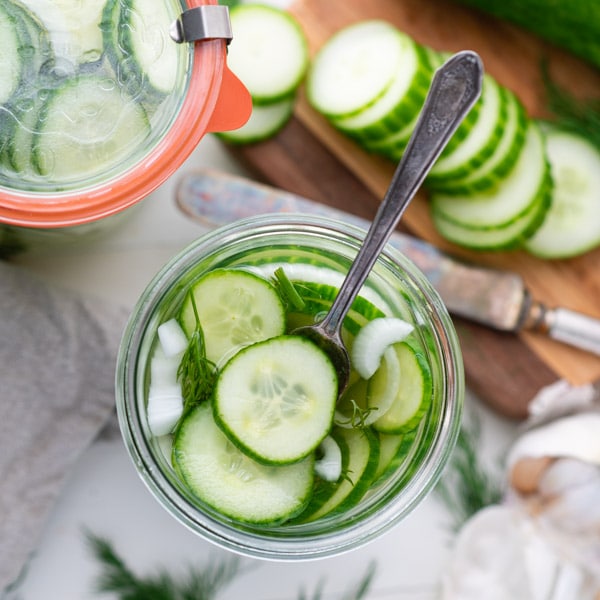
Tips for the Best Refrigerator Dill Pickle Recipe
- Allow time for the brine to cool to room temperature before pouring it over the vegetables.
- Use a wider setting on a mandoline to slice the cucumbers into even rounds quickly and easily.
- Let the pickles sit in the fridge for at least 24 hours to develop their flavor before enjoying. They must always be stored in the refrigerator since they are not properly canned to be shelf-stable.
- Scale the recipe to make as many jars as you like. For a small batch of refrigerator pickles, just cut all of the ingredients in half. If you have a bumper crop of cucumbers to enjoy, you can double the ingredients and prepare twice as many jars!
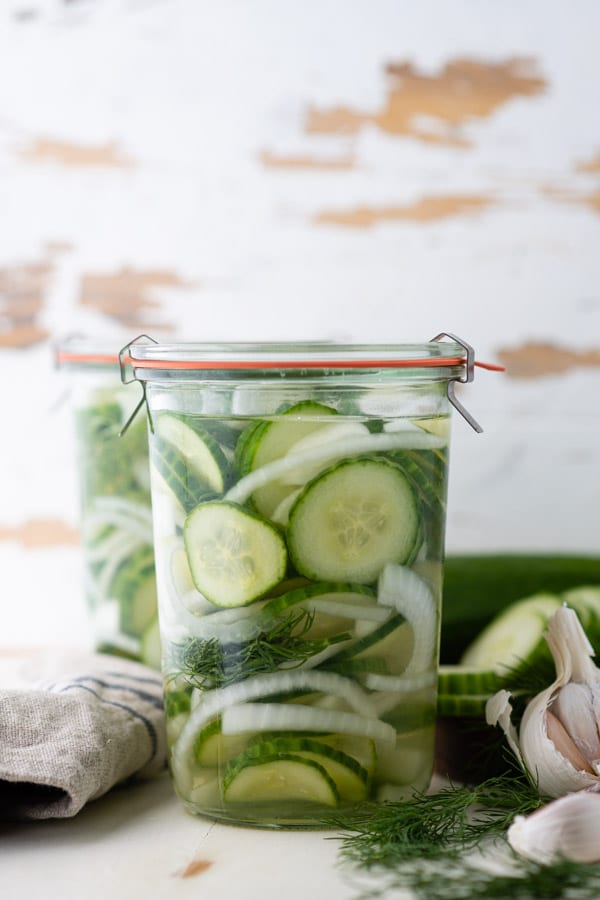
More Recipes with Cucumbers
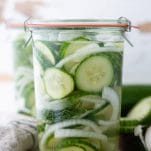
Refrigerator Dill Pickles
Ingredients
- 5 cups water
- 1 cup cider vinegar
- 2 tablespoons kosher salt
- 1 ½ tablespoons granulated sugar
- 1 whole clove garlic, peeled
- 6 cups sliced cucumbers (about 2 ½ lbs.), such as seedless English cucumbers
- 2 cups thinly sliced Vidalia onions (about 1 medium onion)
- 6 sprigs fresh dill
Instructions
- In a saucepan, bring water, vinegar, salt, sugar and garlic clove to a boil over medium-high heat. Whisk to make sure that the sugar and salt are completely dissolved. Remove from heat and let cool to room temperature. Discard the garlic clove.
- Divide cucumbers, onions, and dill sprigs between 3 (1-quart) jars. Add cooled vinegar mixture to cover; seal jars. Refrigerate for at least 24 hours before enjoying. The pickles will last in the fridge for up to 2 months.
Notes
- Some pickle recipes use equal parts vinegar and water for the brine. This brine is more mild and less tangy, which we really love (and it makes it easier to serve the pickles as a side dish). If you prefer a more pungent acidic tang in your pickles, you can decrease the water and increase the cider vinegar.
- For a stronger garlic flavor, place a whole peeled garlic clove in each jar of pickles, rather than just letting the clove infuse the brine.
- If you like a stronger dill flavor, add extra dill sprigs to each jar (you can easily increase the dill to 3-4 sprigs in each jar).
- We love the balance of the pickled cucumbers with the sweet pickled onions. If you prefer fewer onions in your jars, you can decrease the amount of onion called for in the recipe and replace it with extra cucumbers instead.
- For spicy refrigerator dill pickles, add crushed red pepper flakes or whole peppercorns to the brine.
- Try a sweeter pickle by increasing the sugar in the brine.
- Cut the cucumbers into any shape you like. I’ve shown round hamburger chips here, but you can slice them into long sandwich slices, spears, or crinkle cut rounds.
- Let the pickles sit in the fridge for at least 24 hours to develop their flavor before enjoying. They must always be stored in the refrigerator since they are not properly canned to be shelf-stable.
- Scale the recipe to make as many jars as you like. For a small batch of refrigerator pickles, just cut all of the ingredients in half. If you have a bumper crop of cucumbers to enjoy, you can double the ingredients and prepare twice as many jars!

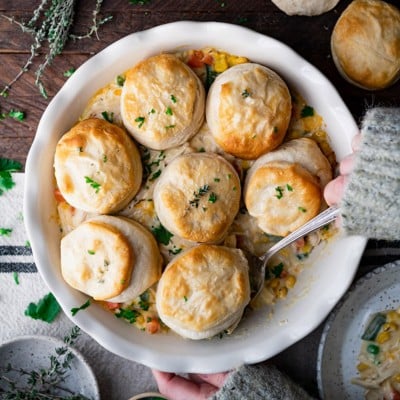
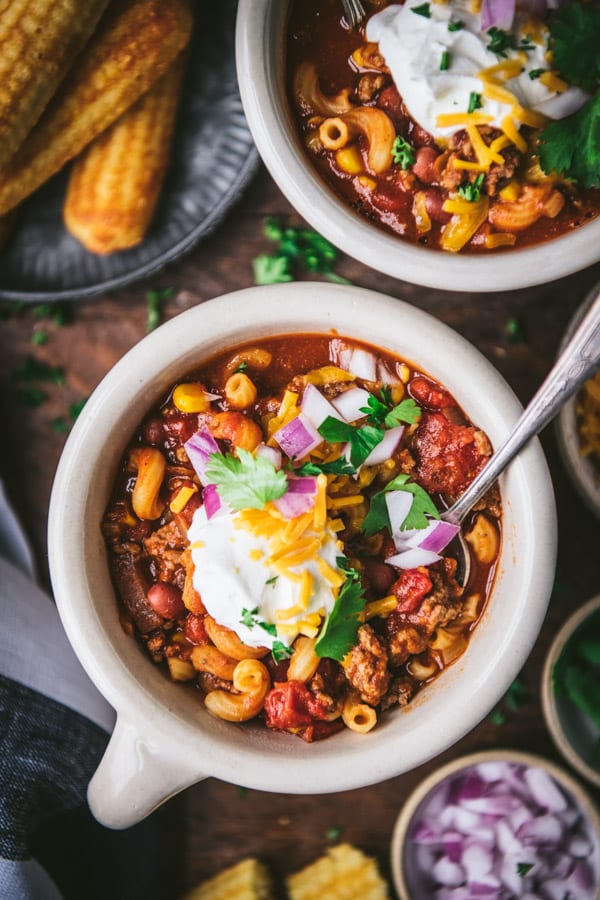
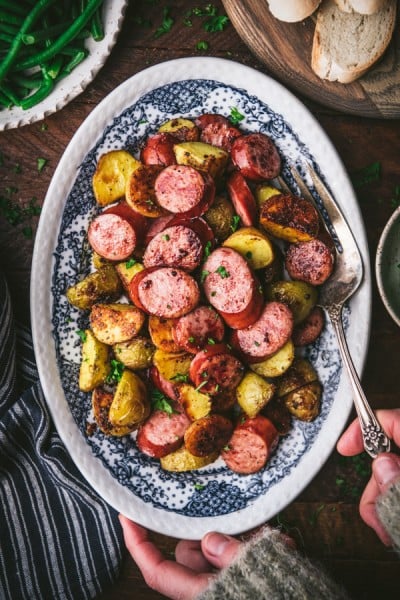








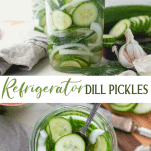
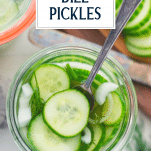
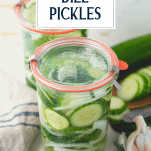
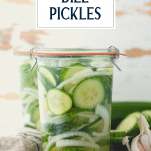
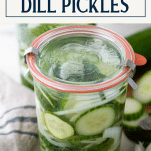
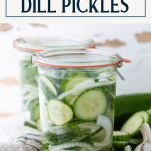
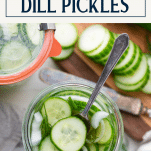
Good morning, Blair! I learned my local store does not sell fresh herbs. Bummer, I know. They do sell dill seed and ground dill weed in the spices, though. What are your thoughts on the best substitution, dill seed or dill weed, and how much?
Oh, darn. That’s a huge bummer, Marion. I would try maybe 1/2 teaspoon of dried dill weed in each jar of pickles. Let me know if you give that a shot!
Will these still keep for two months if you leave out the sugar part?
Yes, but the brine might taste too “sharp” without the balance of a little added sugar. You can do it either way, though!
Hi Blair – I love pickles but I also love pickled beets. Can you use this same recipe to pickle beets or would it need tweaking? Thanks, Karen
Hello Blair
I have to tell you I have made these pickles twice now in the last three weeks and I can’t stop eating them ( better than cookies, lol). They are absolutely delicious and your right I find myself taking the jar out and sticking my (clean) finger in to grab some. Right now I only have one jar left and I just picked up cucumbers to make more. I think I like them because they are not overpowering. The first time I made these I cut the cucumber by hand (which took a little longer, 72 year old hands), now I use my mandolin and I am done in no time, it takes longer for the brine to cool. Thank you so much for posting this recipe …..
Yay! I’m so glad to hear that you’ve enjoyed them, Karen. Definitely a summertime favorite around here, too! 🙂
Hi Blair Karen here again when I made my pickles I used Mortons coarse Kosher salt now I want to make a new batch and I had to buy Davids Kosher salt which is also coarse but a much smaller coarse. I tried to look up the difference between the two as far as measurements but I’m more confused. What brand of Kosher salt do you use? Thanks, Karen
Hi, Karen! I use Diamond Crystal kosher salt. Here’s a link: https://www.amazon.com/Diamond-Crystal-Kosher-Salt-lbs/dp/B0011BPMUK
Everyone loves these pickles! I have had requests for them by several people. I am curious if you have ever canned these. I would love to have them on hand whenever we want some.
We’re so happy this recipe is a hit, Suzie! We haven’t tried canning this recipe and probably wouldn’t recommend it. However, if you do try it out, please let us know how it goes!
Hi, Blair. I made these yesterday and they’re really good so far. It’s a big recipe, for me, so it will be interesting to see how they taste as as the next week or two go by. I may tweak the seasonings, as you mention, but I do believe these will become a standard item in my refrigerator. So beautifully cold and refreshing, low calorie, and it’s wonderful to be really able to Taste The Cucumber. I love pickles but so many brands just kind of slap me with a load of vinegar and/or salt. I plan to try your bread-and-butter pickles as well. Thanks so much.
We’re so glad you enjoyed them, Marion! We’d love to know how it goes if you tweak the seasoning and hope you enjoy the bread-and-butter pickles as well.